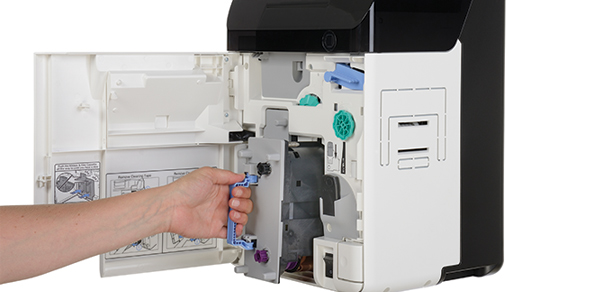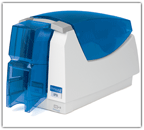Retransfer ups the ante for desktop card printers
Quick, cheap and high-quality all within reach
02 April, 2015
category: Corporate, Financial, Government, Library, Smart Cards
Gains in market share
Insiders predict interest in retransfer printing to grow rapidly in the coming years. Today, reports suggest it accounts for about 15% of printer sales, up from just 5% a few years ago.
“Over time, that might even get up to 20%,” says Connell Smith, vice president of distributed issuance, supplies and secure technology products for Datacard. The retransfer market is growing faster than the direct-to-card market, he notes.
Experts attribute that rise to the increase in the use of smart cards and the fact that costs are coming down for all types of printing. It used to be that a printer that provided good print quality cost $4,000 or more, but today it could cost just $2,500.
At the same time, interest continues to grow for traditional direct-to-card printing.
For printer manufacturer Zebra Technologies, more than 70% of the company’s printing revenues come from low to midrange direct-to-card printers and printer media, says Kelly Ambriz, senior product manager for Zebra.
At both ends of the spectrum, Ambriz says sales are strong with printing unit revenues hitting record levels in a recent quarter. “The market is good right now, and we expect to see that into next year, too,” he says.
Through its Fargo printer line, HID Global has offered both printing methods for a decade and a half, says Jim Meier, senior director of product marketing for HID. He says the growing demand for technology cards drove the addition of retransfer printing to HID’s offerings in 1999.
“There was always this desire to print on these types of cards, and this really was the way to do it in the most effective manner,” he explains.
The case for retransfer
Datacard’s Smith points to three reasons why organizations prefer retransfer printing.
One is for over-the-edge printing in which the image is prominent. Direct-to-card printing produces images that don’t bleed over the edge of a card, and that can create a white line around the border of the card. That might not be an issue for grade school student ID badges, but a financial institution wants a more sophisticated card appearance, he explains. By printing onto a clear film, the retransfer method can produce over-the-edge printing without any white border.
The second is for the flatness of cards. If a card isn’t flat or even, a direct-to-card print head won’t be able to transfer the image reliably. “This is one of the reasons I think retransfer has grown,” Smith says, referring to the increase in the use of smart cards that often have a dimple on the card where the chip is embedded.
The third reason for using retransfer is that it enables printing on a wider range of plastics. Whereas direct-to-card printing works only on PVC plastic because of its porous surface, retransfer can accommodate multiple print surfaces, including sturdier materials such as polycarbonate and PETG. Although PVC accounts for about 90% of the cards printed in the world, high-end government cards sometimes call for stronger types of plastic.
And then there’s added security. Retransfer printing can enable the higher levels of card security by allowing the incorporation of techniques – such as a holographic and other visual security elements – in the transfer film and overlay process.
Cards printed with retransfer film make it easier to detect fraud. “If an attempt to alter the image has been tried, it is easier to detect because the film will be affected,” Ambriz says.



